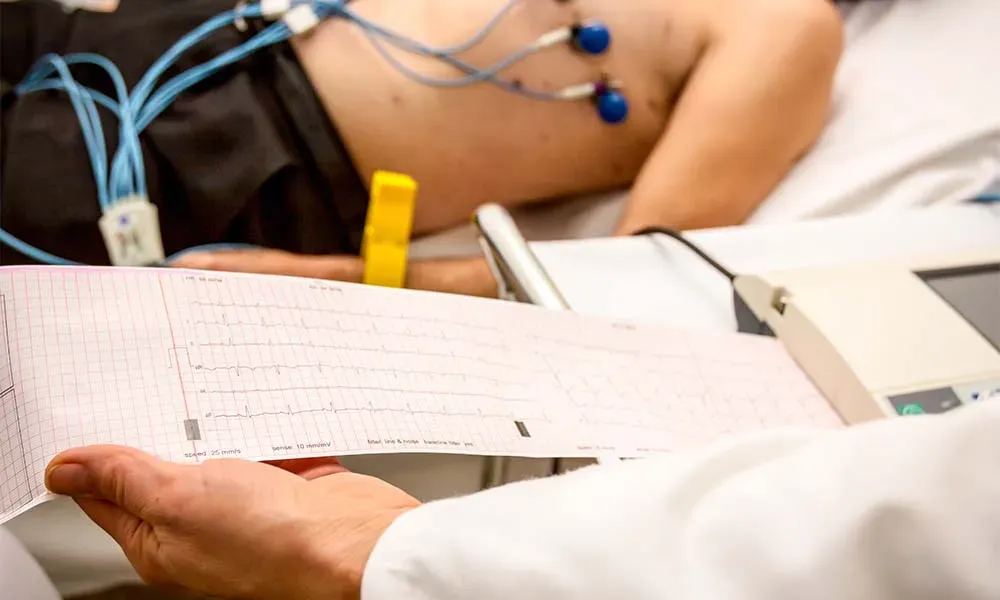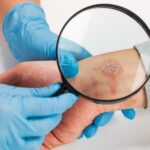
Every second of the day, your heart puts forth a lot of effort in the background to pump blood, deliver oxygen, and keep your body functioning. However, you might not always notice problems right away. An electrocardiogram (ECG or EKG) can help with that.
An ECG is a straightforward, non-invasive procedure that captures your heart’s electrical activity. Even in cases where symptoms are silent or sporadic, it is one of the best tools available to doctors for identifying arrhythmias, atrial fibrillation (AFib/AF), and other cardiac abnormalities.
Your doctor might suggest an ECG if you’ve ever had an irregular heartbeat, chest pain, or unexplained fatigue. This guide describes what the test can detect, how it operates, and when you should think about getting one.
What Is an Electrocardiogram (ECG)?
The electrical impulses that causes your heartbeat are measured by an ECG. To guarantee that your heart beats in a rhythm that is efficient and well-coordinated, these impulses pass through your heart in a precise order.
The ECG machine records and shows these electrical signals as a sequence of waves by applying tiny electrodes to your arms, legs, and chest. These waves reveal your heart’s heart rate, rhythm, and whether any parts of it are damaged or overworked.
The electrocardiogram test takes five to ten minutes and is quick and painless. Usually, a clinic, hospital, or diagnostic facility performs it.
What Can an ECG Detect?
From minor rhythm abnormalities to potentially fatal conditions, an ECG can detect a wide range of heart issues. It offers important hints regarding the general condition and operation of your heart.
The primary conditions that ECGs aid in diagnosing are as follows:
1. Arrhythmias (Irregular Heartbeats)
When the electrical signals that regulate your heartbeat become jumbled or interfered with, arrhythmias happen. While some are benign, others, if untreated, can result in major complications.
Common arrhythmias include:
- Bradycardia: A heart rate that’s too slow
- Tachycardia: A heart rate that’s too fast
- Premature beats: Extra or skipped heartbeats
- Supraventricular tachycardia (SVT): Rapid heart rate originating in the upper chambers
- Ventricular tachycardia: A fast rhythm starting in the lower chambers, which can be dangerous
For the purpose of choosing the best course of treatment, an ECG assists in identifying the kind, frequency, and pattern of arrhythmia.
2. Atrial Fibrillation (AFib/AF)
One of the most prevalent arrhythmias, particularly in adults over 60, is AFib. The heart’s atria, or upper chambers, beat erratically and out of rhythm with the ventricles, or lower chambers, when an individual has atrial fibrillation (AFib).
Blood may pool in the atria as a result, raising the risk of heart failure and stroke.
AFib can occasionally be asymptomatic or persistent. Even in brief episodes, an ECG can verify its existence and assist in determining whether medication or treatments like cardioversion or ablation are necessary.
3. Conduction Abnormalities
To maintain its rhythm, the heart uses a built-in electrical system. Signals passing through this system are occasionally blocked or delayed. This is referred to as a bundle branch block or heart block.
Conduction delays may result in exhaustion, fainting, or the requirement for a pacemaker, depending on their severity. The location and severity of the delay can be determined by an ECG.
4. Heart Attacks (Current or Past)
Myocardial infarction, another name for a current heart attack, can be identified by an ECG. A blocked artery is preventing part of the heart muscle from receiving enough oxygen, as indicated by changes in the ECG wave patterns.
Even if you never experienced symptoms, the electrocardiogram test may still show evidence of a prior heart attack. This is useful for determining risk and organising additional examinations or therapies.
5. Enlargement of the Heart
When the heart is overworked or has to pump against high pressure (as in high blood pressure or valve disease), its chambers may enlarge or thicken. This condition is known as hypertrophy.
An ECG can pick up subtle signs of enlargement, which often precedes more serious complications. Early detection allows for lifestyle changes or medications to relieve the burden on the heart.
6. Electrolyte Imbalances and Medication Effects
Your heart’s electrical activity is influenced by the ratio of minerals like potassium, calcium, and magnesium in your blood. Unusual levels may cause arrhythmias or even resemble the signs of a heart attack.
Additionally, an ECG can track the effects of medications on your heart rhythm, such as antidepressants, antipsychotics, and heart medications, particularly if they are known to lengthen the QT interval, a particular portion of the heart’s electrical cycle.
Types of ECG Monitoring
A typical ECG only captures a few seconds of activity, but certain cardiac conditions are more difficult to detect because they fluctuate.
In these situations, physicians might advise:
Holter Monitor
A portable device that continuously records heart activity and is worn for 24 to 48 hours. It is helpful in identifying arrhythmias that happen intermittently during the day or at night.
Event Monitor
A gadget that is worn for weeks at a time. When you experience symptoms like palpitations, fluttering, or dizziness, you press a button to record. Even if you don’t feel anything, certain versions have the ability to automatically identify and record anomalies.
When symptoms are rare or ambiguous but still cause concern, these long-term ECG tools can be helpful.
When Should You Get an ECG?
Your doctor may recommend an ECG if you experience:
- Chest pain or pressure
- Dizziness or fainting spells
- Shortness of breath
- Heart palpitations or irregular pulse
- Fatigue that doesn’t improve with rest
- A family history of heart disease or sudden cardiac death
ECGs are frequently part of routine check-ups for athletes, older adults, patients undergoing surgery, and people starting new medications, even when there are no symptoms.
Final Thoughts
An electrocardiogram is one of the simplest and most effective ways to detect heart problems early. From arrhythmias and AFib to past heart attacks or conduction blocks, an ECG provides valuable data that can guide treatment, improve outcomes, and even save lives.
If you’re noticing symptoms — or just want a clear picture of your heart health — talk to your doctor about getting tested. It’s quick, painless, and can help uncover issues long before they become serious.
References
- Vital Heart & Vein – How to Diagnose Heart Arrhythmia https://vitalheartandvein.com/news/how-to-diagnose-heart-arrhythmia/#:~:text=An%20event%20monitor%20is%20a%20small%20portable,is%20initiated%20by%20pushing%20an%20event%20button%2C
- American Heart Association – AFib and Heart Rhythm Disorders
https://www.heart.org/en/health-topics/arrhythmia/about-arrhythmia
Better Health Channel – Heart Tests
https://www.betterhealth.vic.gov.au/health/conditionsandtreatments/heart-tests







